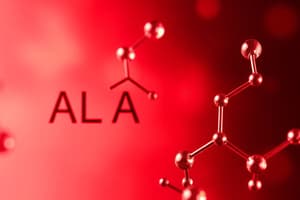Podcast
Questions and Answers
What is the characteristic of alkanes in terms of polarity?
What is the characteristic of alkanes in terms of polarity?
- Ionic
- Nonpolar (correct)
- Polar
- Amphipathic
What is the approximate density range of alkanes?
What is the approximate density range of alkanes?
- 0.8 g/mL to 1.5 g/mL
- 0.62 g/mL to 0.79 g/mL (correct)
- 0.5 g/mL to 1.2 g/mL
- 1.0 g/mL to 2.0 g/mL
What is the state of alkanes with 1-4 carbon atoms at room temperature?
What is the state of alkanes with 1-4 carbon atoms at room temperature?
- Solids
- Gases (correct)
- Semisolids
- Liquids
What is the purpose of applying paraffin wax to fruits and vegetables?
What is the purpose of applying paraffin wax to fruits and vegetables?
What is the common name for a hydrocarbon mixture with 25 or more carbon atoms?
What is the common name for a hydrocarbon mixture with 25 or more carbon atoms?
What is the characteristic of alkanes with 9-17 carbon atoms?
What is the characteristic of alkanes with 9-17 carbon atoms?
What type of bond results from the transfer of electrons?
What type of bond results from the transfer of electrons?
What is the typical bond of compounds of carbon?
What is the typical bond of compounds of carbon?
What happens when the atomic orbitals of two carbon atoms overlap?
What happens when the atomic orbitals of two carbon atoms overlap?
What is the hybridization of carbon when it is bound to two other atoms with the help of two double bonds or one single and one triple bond?
What is the hybridization of carbon when it is bound to two other atoms with the help of two double bonds or one single and one triple bond?
What is the bond angle in a molecule with sp hybridization?
What is the bond angle in a molecule with sp hybridization?
What is the hybridization of a carbon atom when it bonds with three other atoms?
What is the hybridization of a carbon atom when it bonds with three other atoms?
What is the arrangement of bonds in a molecule with sp3 hybridization?
What is the arrangement of bonds in a molecule with sp3 hybridization?
What is the number of hybrid orbitals formed when carbon atoms bond to 4 other atoms?
What is the number of hybrid orbitals formed when carbon atoms bond to 4 other atoms?
Flashcards are hidden until you start studying
Study Notes
Chemical Bonds
- Ionic bonds result from the transfer of electrons
- Covalent bonds result from the sharing of electrons
- Covalent bonds are typical of carbon compounds and are of chief importance in organic chemistry
Hybrid Orbitals
- Hybrid orbitals are formed by mixing (hybridizing) carbon's atomic orbitals
- When carbon bonds to 4 other atoms, the 2s orbital and all three 2p orbitals in the valence shell combine to produce four sp3 hybrid orbitals
- Hybrid orbitals are used to describe the bonds between carbon atoms
sp Hybridization
- Carbon has sp hybridization when bound to two other atoms with the help of two double bonds or one single and one triple bond
- sp hybridization results in a linear arrangement of atoms with a bond angle of 180°
sp2 Hybridization
- Carbon is sp2 hybridized when bonding takes place between 1 s-orbital with two p orbitals
- sp2 hybridization results in a triangular arrangement of atoms with 120° angles between bonds
sp3 Hybridization
- Carbon has sp3 hybridization when bonded to four other atoms
- sp3 hybridization results in a tetrahedral arrangement of atoms with a bond angle of 109.5°
- Example: Hybridization of CH4 (Methane)
Properties of Alkanes
- Alkanes are nonpolar, making them insoluble in water but soluble in nonpolar solvents
- Alkanes have densities from 0.62 g/mL to about 0.79 g/mL, which is less than the density of water (1.0 g/mL)
- Alkanes with 1-4 carbon atoms are gases at room temperature and are widely used as heating fuels
- Alkanes with 5-9 carbon atoms are liquids at room temperature and are used in fuels such as gasoline
- Alkanes with 9-17 carbon atoms have higher boiling points and are found in kerosene, diesel, and jet fuels
- Alkanes with 18 and more carbon atoms are waxy solids at room temperature and are used in waxy coatings
- Alkanes with 25 and more carbon atoms are semi-solid mixtures of hydrocarbons used in ointments, cosmetics, and as a lubricant (e.g. Vaseline)
Studying That Suits You
Use AI to generate personalized quizzes and flashcards to suit your learning preferences.




